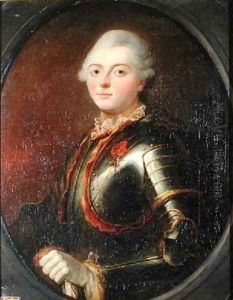Jean Baptiste Lebrun Paintings
Jean Baptiste Pierre Lebrun was a pivotal figure in the art world of 18th and early 19th century France, not only as an artist but more significantly as an art dealer, expert, and husband to the renowned painter Élisabeth Louise Vigée Le Brun. Born in 1748, Lebrun's career spanned a period of great change in France, from the years leading up to the French Revolution through the Napoleonic era and into the early years of the Restoration. His contributions to art history and the art market during these tumultuous times were profound, influencing the way art was collected, valued, and understood.
Lebrun's early life was steeped in art; he was an accomplished painter, although his reputation in this field was eventually overshadowed by his activities as an art dealer and expert. His marriage to Élisabeth Louise Vigée in 1776 linked him with one of the most talented portraitists of the day, further embedding him in the artistic community. Together, they navigated the challenges and opportunities of the art world in a time of social and political upheaval.
As an art dealer, Lebrun was known for his keen eye and deep knowledge of European art, particularly that of the Dutch and Flemish schools. He was instrumental in the development of the art market in Paris, organizing sales and exhibitions that attracted collectors from across Europe. His expertise was not limited to the business side of art; he was also a scholar, writing about art history and contributing to the understanding of art valuation and collection.
The French Revolution and the rise of Napoleon brought significant challenges to Lebrun's career. The changing political landscape affected the art market deeply, with the seizure of aristocratic collections and the shifting tastes of the new elites. Despite these challenges, Lebrun adapted, continuing to deal in art and engage with the evolving cultural policies of the Napoleonic regime. After the fall of Napoleon, Lebrun worked to restore looted artworks to their rightful places, a testament to his enduring commitment to the art world.
Jean Baptiste Pierre Lebrun's death in 1813 marked the end of an era for the French art market. His legacy, however, lived on through his writings and the continued influence of his wife, whose portraits remain celebrated to this day. Lebrun's life and work provide a fascinating window into the complexities of the art world during one of the most tumultuous periods in French history, showcasing the resilience and adaptability of those who shape the cultural landscape.
